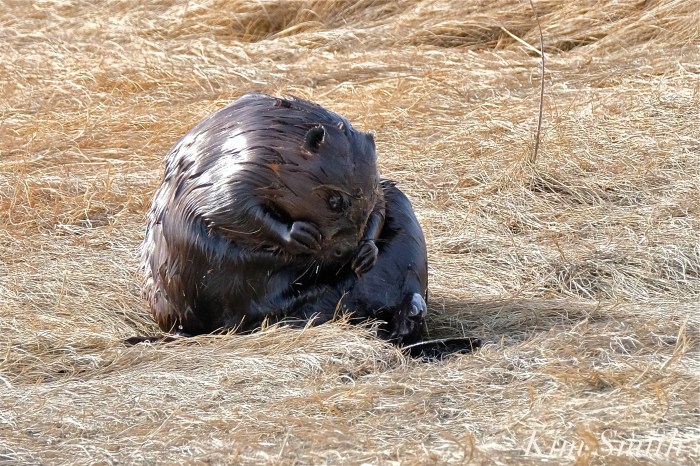Puttering through a cut in the marsh, a moving brown shape appeared. Much too big to be a muskrat, and too small to be an otter, it was a very large and pleasantly plump Beaver!
He swam through several small pools of water then climbed out onto dry land to oil his fur. Beavers have a pair of glands located at the base of their tails that produce a fatty, waxy secretion called castoreum. The Beaver combs the castoreum through his fur to waterproof, enabling him to swim without getting his body wet.
Beavers don’t see or hear very well, but they have an amazing sense of smell. They also use the castoreum to mark their territory. The substance is surprisingly pleasantly scented, made pleasant by the Beaver’s diet of tree bark, twigs, stems, and buds.
Beaver waterproofing his fur.
The castoreum smells of vanilla and raspberry, with sweet floral notes. You could actually say, Beaver butts smell great!
After pausing briefly, the chubby fellow waddled back across the marshy land, heading for deeper water.
Where do Beavers go during the winter months and do they hibernate? Beavers are less active in the winter, but they do not hibernate. They spend the winter in a cozy cone-shaped winter lodge built of sticks and mud. When the muddy wall freezes, it is nearly as strong as cement. The Beavers leave a ventilating hole open at the top of the cone. On a cold winter day, you can see steam arising from the hole of an active beaver lodge, and also, if close enough, smell and hear the activity within. Winter dwellers of a beaver lodge might include the Mom and Dad, yearlings, kits born the previous year, and even possibly a muskrat family.
There are two tiers to the upper part of the lodge that is above the waterline, the lower for feeding and for drip-drying, and the higher tier for sleeping. The sleeping platform is cushioned with grass and shredded wood fibers. The snow pack above, the chamber’s thick walls (two to three feet thick) and heat generated by the lodge dwellers keeps the den toasty warm (by Beaver standards). One study showed that a Beaver lodge in Ontario maintained a fairly constant temperature of 32 degrees while the temperature outdoors ranged from -6 degrees to 19 degrees.
In anticipation of winter, Beavers stock pile great caches of the bark and stems of aspen, maple, willow, birch, black alder, dogwood, and black cherry trees. They also eat a great deal, and the fat is stored in their bodies and tails; the size of the tail fluctuates with seasons. The Beavers huddle together on the sleeping platform, eating less during the winter, which helps keep their activity levels low and reduces their metabolic rate.
Happy Spring!










